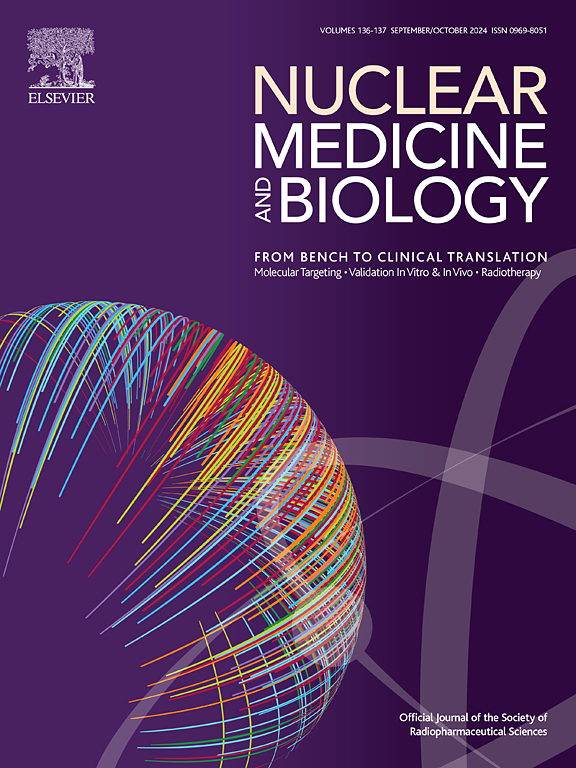Biodistribution of [18F]BCPP-BF in humans: a first-in-human positron emission tomography study
IF 3.6
4区 医学
Q1 RADIOLOGY, NUCLEAR MEDICINE & MEDICAL IMAGING
引用次数: 0
Abstract
Introduction
[18F]BCPP-BF and [18F]BCPP-EF are PET probes used to evaluate mitochondrial function by targeting MC-I. Clinical studies on [18F]BCPP-EF have been reported, particularly brain studies. However, no reports exist on the use of [18F]BCPP-BF in humans. Therefore, in this study, we aimed to apply [18F]BCPP-BF to humans for the first time to assess its safety and radiation dose. We also aimed to explore the whole-body distribution of both probes by comparing the data acquired from the same participants.
Methods
Ten healthy participants underwent whole-body PET/CT measurements of [18F]BCPP-BF (117.0–153.8 MBq/body) for 90 min. Approximately 2–3 weeks after the measurements, the participants underwent [18F]BCPP-EF (109.2–158.8 MBq/body) measurements. Thirteen volumes of interest (VOIs) were manually drawn on the brain and peripheral organs using PET/CT images to evaluate the distribution and kinetics of the probes. The equivalent dose for each organ and the whole-body effective dose for each participant were calculated according to the Medical Internal Radiation Dose schema using OLINDA/EXM software.
Results
The highest radiation doses from the administration of [18F]BCPP-BF were observed in the small intestine (65.5 ± 8.7 μGy/MBq), and the estimated effective dose (16.3 ± 2.3 μSv/MBq) was well-tolerated. There were no clinically significant safety concerns. A high accumulation of [18F]BCPP-BF was observed in the kidney, pancreas, and heart, consistent with the findings in previously reported animal studies. The distributions of both tracers were similar. However, the kinetics of [18F]BCPP-BF were different, with higher uptake and slower washout in the kidney and pancreas, and lower uptake and slower washout in the brain and liver, from those of [18F]BCPP-EF.
Conclusion
[18F]BCPP-BF is safe and acceptable for clinical use owing to its low toxicity and radiation dose. [18F]BCPP-BF and [18F]BCPP-EF generally exhibited similar whole-body distributions; however, their organ-specific kinetics differed slightly. The appropriate selection of these probes can provide a more accurate assessment of human mitochondrial function.

[18F]BCPP-BF在人体内的生物分布:首次人体正电子发射断层扫描研究
[18F]BCPP-BF和[18F]BCPP-EF是通过靶向MC-I来评估线粒体功能的PET探针。已有关于[18F]BCPP-EF的临床研究报道,特别是脑研究。然而,没有关于在人类中使用[18F]BCPP-BF的报道。因此,在本研究中,我们旨在首次将[18F]BCPP-BF应用于人体,评估其安全性和辐射剂量。我们还旨在通过比较从同一参与者获得的数据来探索两种探针的全身分布。方法10名健康参与者进行全身PET/CT测量[18F]BCPP-BF (117.0-153.8 MBq/体)90分钟。测量后约2-3周,参与者进行[18F]BCPP-EF (109.2-158.8 MBq/体)测量。使用PET/CT图像在大脑和周围器官上手动绘制13个感兴趣体积(VOIs),以评估探针的分布和动力学。使用OLINDA/EXM软件根据医学内辐射剂量表计算每个器官的等效剂量和每个参与者的全身有效剂量。结果[18F]BCPP-BF给药小肠辐射剂量最高(65.5±8.7 μGy/MBq),估计有效剂量(16.3±2.3 μSv/MBq)耐受性良好。没有明显的临床安全性问题。在肾脏、胰腺和心脏中观察到[18F]BCPP-BF的高积累,这与先前报道的动物研究结果一致。两种示踪剂的分布相似。然而,与[18F]BCPP-EF相比,[18F]BCPP-BF的动力学不同,其在肾脏和胰腺的摄取较高,冲刷速度较慢,在脑和肝脏的摄取较低,冲刷速度较慢。结论[18F]BCPP-BF毒性低,辐射剂量小,可安全用于临床。[18F]BCPP-BF和[18F]BCPP-EF总体分布相似;然而,它们的器官特异性动力学略有不同。适当选择这些探针可以提供更准确的评估人类线粒体功能。
本文章由计算机程序翻译,如有差异,请以英文原文为准。
求助全文
约1分钟内获得全文
求助全文
来源期刊

Nuclear medicine and biology
医学-核医学
CiteScore
6.00
自引率
9.70%
发文量
479
审稿时长
51 days
期刊介绍:
Nuclear Medicine and Biology publishes original research addressing all aspects of radiopharmaceutical science: synthesis, in vitro and ex vivo studies, in vivo biodistribution by dissection or imaging, radiopharmacology, radiopharmacy, and translational clinical studies of new targeted radiotracers. The importance of the target to an unmet clinical need should be the first consideration. If the synthesis of a new radiopharmaceutical is submitted without in vitro or in vivo data, then the uniqueness of the chemistry must be emphasized.
These multidisciplinary studies should validate the mechanism of localization whether the probe is based on binding to a receptor, enzyme, tumor antigen, or another well-defined target. The studies should be aimed at evaluating how the chemical and radiopharmaceutical properties affect pharmacokinetics, pharmacodynamics, or therapeutic efficacy. Ideally, the study would address the sensitivity of the probe to changes in disease or treatment, although studies validating mechanism alone are acceptable. Radiopharmacy practice, addressing the issues of preparation, automation, quality control, dispensing, and regulations applicable to qualification and administration of radiopharmaceuticals to humans, is an important aspect of the developmental process, but only if the study has a significant impact on the field.
Contributions on the subject of therapeutic radiopharmaceuticals also are appropriate provided that the specificity of labeled compound localization and therapeutic effect have been addressed.
 求助内容:
求助内容: 应助结果提醒方式:
应助结果提醒方式:


